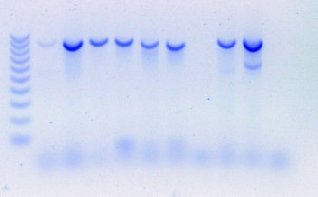MBG Research Associate; REU PI and Coordinator
Research Interests
• Systematic Botany
• Molecular Techniques, DNA Sequencing
• Plant Anatomy, Morphology, Cytology
• Flora of Missouri, Southwestern U.S., Mexico
• Agavaceae, Monocots, Legumes, Cycads
• Conservation Genetics
• Interactive Keys
Web Page: MBG
Project 1: DNA Barcoding the Plants of Shaw Nature Reserve. An exciting new development in plant systematics is the rise of DNA barcoding - the use of standardized short DNA sequences to identify plants and animals to the species level (CBOL Plant Working Group 2009). Although not without problems, DNA barcodes have the potential to revolutionize plant taxonomy by making it possible for non-specialists to identify species quickly and efficiently. Applications are found in conservation biology where they can be used to rapidly identify endangered, invasive, or rainforest species. MBG has a project to generate a 2-gene DNA sequence barcode for all plant species at the Garden's Shaw Nature Reserve. This reserve consists of 2,400 acres of Ozark forest, bottomland forest, riparian areas, natural glades and restored tall-grass prairie. In total, the reserve contains 1,053 species, 503 genera, and 151 families of plants, including bryophytes. Students who choose this project will become familiar with the plants and communities at SNR through weekly field trips, collect and identify plants using keys and the herbarium, prepare high quality voucher specimens, preserve leaf material in silica for DNA, extract DNA using FastPrep kits, run gels, and amplify the specific DNA barcode regions (rbcL, matK). Primers for these regions have been designed to work for a broad range of plants. Barcode sequences will be uploaded to GenBank and the Barcode of Life Database (BOLD) to make them available to the public. The sequences will be compared with other species in the genus as well as with sequences from the same species from elsewhere in its range that are already in the database. Blind tests will be performed to see how well the barcodes identify species. Publications will discuss the effectiveness of barcoding sequences in identifying species and regional variation.
Project 2: Pollen Atlas of Missouri Plants: Shaw Nature Reserve. Plant pollen and pollinators are important and often under-appreciated components of natural and agricultural ecosystems. All plants produce pollen. About 70% of all plants require animal pollinators, including 35% of crops worldwide, yet we know little about pollen and native pollinators of our non-crop species. As part of a larger collaborative project on pollination biology, we are producing an online pollen atlas of Missouri plants, with multiple pollen images, an interactive key to identification, pollen descriptions, and information on pollination biology. Currently there is no single source for this information, and many species in Missouri lack even minimal information on pollen or pollinators. We are starting with one species from each of the 422 genera of flowering plants at Shaw Nature Reserve, and eventually plan to include all 878 genera of vascular plants in Missouri. The students will collect and identify specimens at SNR, prepare voucher specimens, process pollen samples using acetolysis, and prepare specimens for SEM using the JEOL 5000 tabletop SEM in our lab. Students will research the literature for information on pollination biology and possibly make original field observations on flower visitors and pollination biology. With guidance, students will prepare pollen descriptions and add their taxa to the interactive key, along with information about pollination biology. The results will be incorporated into the online Missouri Pollen Project webpage (prototype).
Selected Publications
- Bogler, D. J.and G. Yatskievych. 2013. Fabaceae. In: G. Yatskievych (Ed.), Steyermark's Flora of Missouri, Volume 3, Missouri Department of Conservation and Missouri Botanical Garden.
- Bogler, D. B. 2011. Missouri Pollen Project.
- Bogler, D. B. 2010. Key to Monocots of the U.S.
- Bogler, D. B. 2009. Key to Legumes of the U.S.
- Bogler, D. B. 2008. Key to Grasses of the U.S.
- Bogler, D. J., J. C. Pires, and J. Francisco-Ortega. 2006. Phylogeny of Agavaceae based on ndhF, rbcL, and ITS Sequences: Implications of molecular data for classification. In: Columbus, J.T., E.A. Friar, J.M. Porter, L.M. Prince, and M. G. Simpson [eds.]. Monocots: comparative biology and evolution. 2 vols, p. 311-326. Rancho Santa Ana Botanic Garden, Claremont, California, USA. [PDF]
- Bogler, D. J. and J. Francisco-Ortega. 2004. Molecular systematic studies of Cycads: evidence from trnL and ITS2 rDNA sequences. Botanical Review 70(2): 260-273. [PDF]
- Bogler, D. J. 2006. Cucurbitaceae. In: G. Yatskievych (Ed.), Steyermark's Flora of Missouri, Volume 2, p. 974-988. Missouri Department of Conservation and Missouri Botanical Garden.
 |
 |